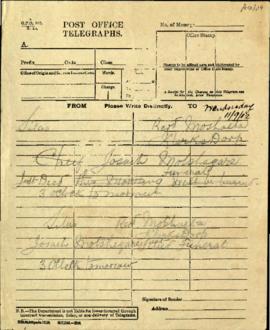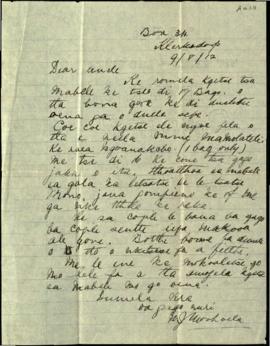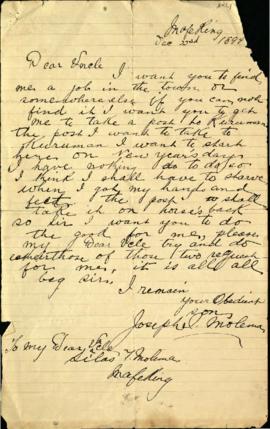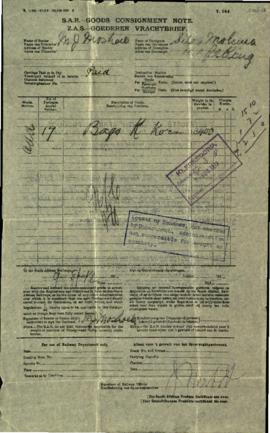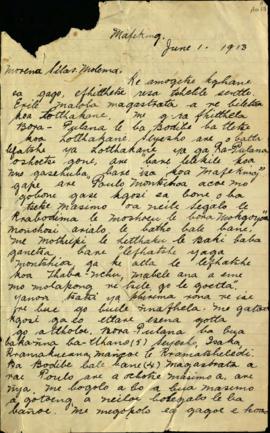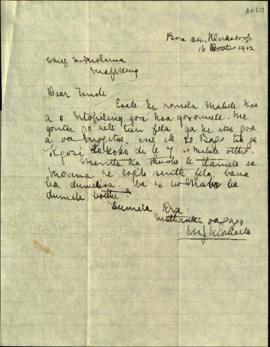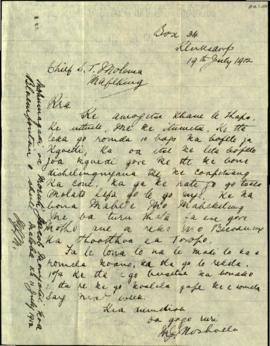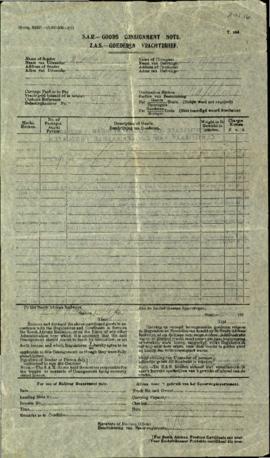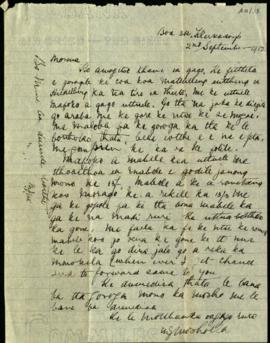Identity area
Reference code
Title
Date(s)
- 1874 - 1976 (Creation)
Level of description
Fonds
Extent and medium
Extent2679 items
Context area
Name of creator
Biographical history
The Molema Family
Helena, the younger brother of Montshiwa, converted to Christianity in about 1840, which caused a rift between him and Montshiwa. Molema founded Mafikeng (Mafeking) in 1857, and Montshiwa settled at Sehuba. In 1882 Montshiwa's territory was threatened by the desire of the Transvaal Boers to expand westwards. He was attacked by the pro-Boer Tswanas chiefs Moshwete and Mntlaba, and eventually he had to take refuge in Mafeking. Molema gave him supremacy over the town on the condition that he would not interfere with the spread of Christian teachings.
Molema's sons, Joshua and Silas, feature prominently in the history of the Tshidi Rolong. Joshua, the elder son, acted as regent to John (Bakolopang) from 1915-1917. His papers cover the years of his chieftainship from 1896 until his death in August 1910.
Silas Thelensho Molema was born in Bechuanaland circa 1852-1855. He received his education at Healdtown, obtaining a teaching certificate in 1877. Thus, on his return to Mafeking in 1878 he established a school for the Rolong, probably the first in Bechuanaland. When the Royal Commission was out in 1881 at the end of the first South African War and marked out the western boundary of the Transvaal, Molema served as one of Montshiwa's counsellors, protecting against the encroachment of the new convention line. He was appointed private secretary to the Paramount Chief in1808. He served the British during the South African War, and commanded a Rolong detachment under Baden-Powell during the siege of Mafeking 1900-1901. He was a landowner and trader.
In 1901 he gave financial support to Solomon T Plaatje, whom he regarded as a son, to publish a Tswana newspaper, Koranta ea Becoana.
Molema supported the formation of the South African Native National Congress (later the African National Congress) and helped the delegations of 1914 and 1919 which went to Great Britain to got the Native Land Act (1913) repealed. Before his death in September 1927 he successfully led a deputation to General Hertzog in Cope Town, to protest against certain provisions of the Native Administration Act (1927).
Seetsele Modiri Molema was Silas Molema's oldest son. He was born in 1892 in Mafeking and received his education at Healdtown and Lovedale. He matriculated in 1912 and taught at the Lyndhurst Road Public School until his departure for Great Britain in March 1914. He studied medicine at Glasgow University, graduating in 1919. While in Scotland he wrote and published The Bantu, past and present (Edinburgh: Green, 1920). After graduating he continued his studies and worked for a time in Dublin and Glasgow, before returning to South Africa early in 1921.
On his return to Mafeking he opened up a surgery for the Indian and Coloured population. Subsequently he opened up a nursing home for all races but due to difficulties had to close down the home. He was an active member of the Rolong tribe, always supporting the Bechuanaland government, and served as a member of the Native Advisory Council. He also served as Treasurer-General of the African National Congress. S M Molema was also an active church member of the Wesleyan Methodist Church.
He married c1927 Anna Moshoela, the daughter of Rev M J Moshoela of Klerksdorp, one-time secretary and friend of Chief Montshiwa. His second wife Lucretia is still living in Mafeking. He died on August 13 1965.
His published works include Chief Moroka: his life, his times, his country and his people (Cape Town: Methodist Publishing House,1951) and Montshiwa 1815-1896: Barolong chief and patriot (Cape Town: Struik,1966).
Solomon Tshekisho Plaatje
Sol. T. Plaatje was born on the farm Doornfontein in the Boshof district on October 9 1876. He was educated at Pniel at the mission school established by the Berlin Missionary Society, from 1884 to 1890. In 1894 he worked as a postman in Kimberley, while studying for the Cape Civil Service Certificate. He moved to Mafeking where he became a court interpreter and magistrate's clerk, having at his command a knowledge of about ten languages. He rendered valuable service as an interpreter to the British during the South African War.
In 1901, backed financially by Chief Silas Molema, he begun editing the Koranta ea Becoana, the first Tswana-English weekly newspaper. In 1910 he moved to Kimberley where he edited the Tsala ea Becoana which changed its name to Tsala ea Batho in 1912. The newspaper ceased publication in 1915 because of Plaatje's presence in Britain.
Plaatje was not only an interpreter, journalist and an author but also a politician. When the South African Native National Congress was formed in 1912, Plaatje became General Corresponding Secretary. When the question of native land arose in 1913 Plaatje became a member of the delegation which went to Britain in 1914 to petition the British government. Despite the outbreak of World War I, which prevented the delegation from achieving its mission, Plaatje remained in England. During this time he wrote Native life in South Africa, before and since the European war and the Boer rebellion (London,1916), arguing the cause of the deputation and the land issue. Returning to Kimberley, he then established The Diamond Fields Men's Own Brotherhood, a body which propagated racial harmony. He returned to Europe in 1919 heading the African National Congress delegation, which attempted to get the Native Land Act discussed at the Peace Conference at Versailles. Subsequently he visited the United States and Canada in 1921.
Plaatje wrote extensively, contributing articles to English and Black newspapers, as well as producing literary works such as Mhudi: an epic of South African native life a hundred years ago (Lovedale,1930), as well as translating some of Shakespeare's works, The Comedy of Errors and Julius Caesar, into Tswana.
In 1898 he married Elizabeth Mbelle, the sister of I Bud Mbelle, an important court interpreter and one time general secretary of the African National Congress. They had four sons, St Leger, Richard, Halley and Johann Gutenberg, and two daughters, Olive and Violet. Plaatje died on June 19 1932, while on a visit to Johannesburg and was buried at Kimberley.
The Rolong (Tshidi branch)
The Rolong are a Tswana tribe. About 1775 a split occurred within the tribe resulting in four branches, the Ratlou, Tshidi, Seleka and Rapulana, the Tshidi forming the largest branch.
The Molema-Plaatje papers include the records of the Tshidi Rolong from the later years of Chief Montishwa's rule. Montshiwa became chief in 1849 on the death of his father Tawana. The tribe had traditionally settled at Lotlhakane but were constantly on the move because of threatened attacks. Mafeking was established as a settlement by his brother Molema, and Montshiwa finally joined him there after losing his land at Dithakong in a dispute with the Rapulana Rolong of Polfontein.
As a result of the threat of the Boers, the freebooters and the loss of their land when the Republics of Stellaland and Goshen were established, the Tahidi Rolong eagerly accepted John Mackenzie's offer to declare the territory a British protectorate. Thus in 1904 with the signing of the London Convention, Bechuanaland came under British protection. However the freebooters launched another attack on the Rolong at Mafeking, and the Transvaal broke the convention by annexing the Rolong territory. Subsequently the Warren expedition of 1885 ensured the Rolong of British protection.
In 1895 the territory came under the administration of the British South Africa Company. After the Jameson Raid which was launched from the Rolong's country, British Bechuanaland was annexed to the Cape. Montshiwa retained his headquarters at Mafeking although many Rolong living north of Ramathlabama Spruit came under the administration of the Bechuanaland Protectorate. Thus the country of the Rolong was divided.
Barolong chiefs (Tsidi branch)
Montshiwa 1849-1896
Wessels (Besele) 1896-1903
Badirile 1903-1911
Lekoko 1911-1915
Joshua 1915-1917
John (Bakolopang) 1917-1919
Lotlamoreng 1919-1954
Archival history
The papers of Silas T Molema and Solomon T Plaatje also include the papers and literary manuscripts of S Modiri Molema. The provenance of the papers is varied. Those of Silas Molema, which include family papers, correspondence with Plaatje and papers relating to the Rolong tribe, were in the possession of his son Morara T Molema. Victor Molema, the son of Plaatje's daughter, Violet, had miscellaneous material of Plaatje's, which included photographs, press clippings and a typescript presumably written by Plaatje describing a visit to the United States of America. Lucretia Molema, the widow of S M Molema, had an unpublished Plaatje MS, Sekgoma: The Black Dreyfus, photographs and postcards given to her husband by Plaatje, as well as her husband's literary manuscripts
The documents were located by Tim Couzens, African Studies Institute (formerly Department of English), University of the Witwatersrand, and Brian Willan, School of Oriental and African Studies (formerly Centre of International and Area Studies), University of London, and were subsequently purchased by the library. Most of Silas Molema's papers were found in a wooden box in a storeroom in Mafeking. The papers were in no particular order although the Rolong tribal papers had been kept separate from family papers. They were in bad condition and deterioration had been caused by insects, dust and vermin.
Immediate source of acquisition or transfer
Content and structure area
Scope and content
A substantial proportion of the documents are in Tswana. The Rolong tribal papers were easy to identify as most are on paper with the tribal letterhead. Most of Plaatje's correspondence is in Tswana, and as he discusses important developments in South African history, the correspondence had to be translated. Thus a Calendar could be compiled to describe the documents. The Ca1endar format has also been used to describe the papers of Chief Montshiwa.
In the body of the inventory names and places are spelled as they appear in the documents, and because of the inconsistency in Tswana orthography the same name may have various spellings. The term "native" instead of African or Black reflects the usage current at the time, and has been retained when describing documents. All references to the Rolong refer to the Tehidi branch of the tribe, and where other branches are meant they are referred to specifically e.g. Rapulana Rolong.
In the index (unpublished) modern spelling of names has been used, thus Montshiwa and not Montsioa. Where there are various spellings the one most commonly used has been chosen and the variations in spelling appear in brackets after the chosen form. If a person is usually referred to by his English first name, the Tswana name appears in brackets after the English names, thus Chief Wessels (Boccie) Montshiwa. It is a Tswana custom to refer to a person by the name of his father thus Seetsele Modiri Molema is sometimes referred to as Silas Modiri Molema.
It is also customary to call a woman after the name of her first born thus Elizabeth Plaatje is often called Ma Sainty, Sainty being the nickname for St Leger, her eldest son. Married women have been indexed under their married name with a reference from their maiden name. Place names are indexed under the English or Afrikaans name rather than the Tswana name and the modernised spelling of the name as used at the time of the compilation of the documents is preferred, thus Bechuanaland and not Botswana. In general, references to Bechuanaland in the documents do not differentiate between British Bechuanaland and the Bechuanaland Protectorate, therefore most references in the index will be to Bechuanaland unless a document refers specifically to either of these territories. The prefixes from the names of Bantu tribes have been dropped in accordance with current usage but have been retained in the body of the inventory, thus Rolong in the index and not Barolong.
Many of the people have been difficult to identify and family relationships are often difficult to establish. Therefore in order to increase the value of the index elementary biographical information has been included. In general, R F Hunnisett's Indexing for editors (British Records Association, 1972) has been consulted.
The papers cover a wide range of subjects such au history and local history in particular, politics, ethnology and social anthropology and Black literature and journalism. The papers of Chief Montshiwa document the encroachment of the Boers, the Warren Expedition and the annexation of British Bechuanaland in 1885. Others document the South African War, in particular the siege of Mafeking in which the Rolong played an important role; the formation of the South African Native National Congress; the Native Land Act (1913) and the delegations to England in 191L and 1919 to protest against the legislation and in particular Plaatje's participation. General tribal administration is reflected in the documents, both by the chiefs and the British (later South African) government officials. Prom the ethno-sociological point of view the papers represent a bourgeois, educated and Westernised.
Black family. The papers are also of literary interest, both Plaatje and S M Molema having made significant contributions to South African Black literature:
I would like to acknowledge the valuable assistance of Tim Couzens and Brian Willan. Mr Couzens was able to obtain information from living members of the Molema and Plaatje families, which helped to identify individuals and photographs. In order to establish complicated family relationships he has compiled a family tree of the Molema family (p.xiii, based on information obtained from Mr Morara T Molema, in interviews which took place on the 2-3 June 1978.
The following abbreviations have been used:
SANNC - South African Native National Congress.
Appraisal, destruction and scheduling
Accruals
System of arrangement
As all the papers are so closely interrelated they have been grouped as one collection. The basic arrangement of the papers is based on the following principles, a) individual by whom the documents were created, b) individual by whom the documents were collected, c) individual or group to whom the documents refer.
Conditions of access and use area
Conditions governing access
Conditions governing reproduction
Copyright Historical Papers Research Archive, The Library, University of the Witwatersrand, Johannesburg, South Africa
Language of material
Script of material
Language and script notes
Physical characteristics and technical requirements
Finding aids
Uploaded finding aid
Allied materials area
Existence and location of originals
Existence and location of copies
Related units of description
Notes area
Note
Alternate title: Molema, Silas T. and Plaatje, Solomon T.
Note
The complete digitisation of this collection was funded by a generous grant from The Atlantic Philanthropies
Alternative identifier(s)
Access points
Subject access points
Place access points
Name access points
Genre access points
Description control area
Description identifier
Institution identifier
Rules and/or conventions used
Status
Level of detail
Dates of creation revision deletion
Language(s)
Script(s)
Sources
Archivist's note
The inventory was compiled by Marcella Jacobson, May 1978
Archivists' notes
The 'Indian Opinion' (Item Aa6) has been digitised in 2011. The complete collection was digitised and published on the Historical Papers website in 2013.


